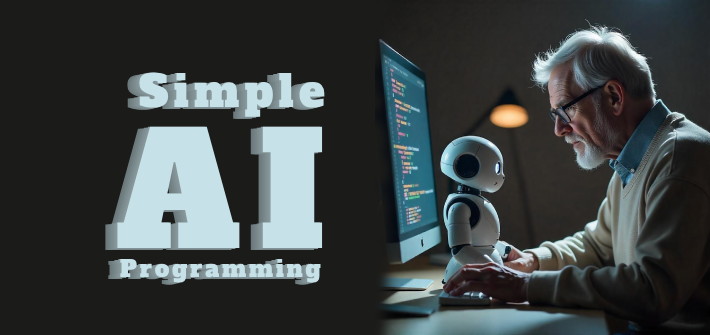Introduction
Artificial Intelligence (AI) has become an integral part of cutting-edge technology. It is revolutionizing industries and simplifying obligations that after required human attempt. As referred to in previous articles, AI has made everything simpler by using automating procedures and boosting performance. However, AI can still appear complicated, specifically for beginners. This article will break down the concept of Simple AI . It provides an easy-to-understand guide for the ones curious approximately the basics of artificial intelligence and the way it connects with programming.
We’ll explore SimpleAI systems. A key focus may be on how programming language processing performs a vital role in AI improvement. Whether you’re a developer seeking to enhance your capabilities or just curious about AI, this manual will simplify the arena of artificial intelligence for you.
Table of Contents
What is Simple AI? Understanding Artificial Intelligence in Simple Terms
At its core, artificial intelligence refers to the ability of machines and computer systems to perform tasks that would typically require human intelligence. These tasks range from speech recognition to problem solving. Learn from experience For example, when we talk about simple AI, we mean AI systems that have straightforward functionality. These systems are typically used in applications such as chatbots, virtual assistants, and simple automation tools. Moreover, their ease of use and implementation makes them accessible for various industries.
How Does Simple AI Work?
To understand how simple AI functions, it’s essential to look at how it processes information. First of all, AI works by collecting large amounts of data. Analyze patterns within that data and use those patterns to make predictions or decisions. In this process, algorithms — AI systems that follow rules — play a key role in getting things done.
For better clarity, let’s break this down using an easy-to-understand analogy. Imagine AI as a recipe for baking a cake. The recipe (algorithm) provides the instructions for mixing ingredients, baking, and eventually producing the final product (the task). In the case of simple AI systems, these recipes are relatively basic and are designed to complete one or two specific tasks efficiently.
Applications of Simple AI in Everyday Life
Simple artificial intelligence is quietly integrated into our daily routines. You may not realize it. But you interact with AI technology many times every day. Here are a few examples of how simple AI powers the tools we use:
- Virtual Assistants (e.g., Siri, Google Assistant, Alexa): These tools utilize simple AI to understand spoken commands and perform actions like setting reminders, answering questions, or controlling smart home devices.
- Chatbots: Many websites use chatbots to offer customer support. These bots rely on simple AI to answer frequently asked questions or guide users through basic troubleshooting steps.
- Recommendation Systems: When you shop online or stream movies, the recommendations you receive are driven by simple AI. It looks at your previous interactions and suggests products or content that align with your preferences.
- Spam Filters: Email services rely on simple AI to sort your inbox, directing spam and junk mail to the appropriate folders while keeping your primary inbox clutter-free.

Programming an AI: A Beginner’s Guide to Simple Artificial Intelligence Development
Artificial intelligence refers to the ability of machines to mimic human intelligence. These systems use algorithms and data to perform tasks such as speech recognition, decision making and problem solving. Although AI comes in many forms, the two main areas are narrow AI designed for specific tasks (such as facial recognition), and advanced AI, which allows humans to perform any kind of cognitive task.
Getting Started with Programming an AI
For those new to programming AI, the concept might seem daunting. However, by following simple steps and focusing on the basics, you’ll be able to create your own AI programs in no time.
1. Understanding Basic AI Concepts
Before jumping into coding languages, it’s essential to grasp some basic AI concepts:
- Algorithms: At the heart of any AI is an algorithm. This is a set of rules that the AI follows to perform a task. For instance, an AI used in facial recognition will have an algorithm that tells it how to identify features in an image.
- Machine Learning (ML): A subset of AI, ML allows systems to learn from data. Instead of hard-coding every action, ML algorithms improve as they process more data.
- Neural Networks: Inspired by the human brain, neural networks consist of layers of nodes (neurons) that process information. These are essential for tasks like speech recognition and image classification.
2. Choosing the Right AI Coding Languages
When it comes to programming an AI, choosing the right language is crucial. The best language for you depends on your goals, whether you’re working on a small project or a complex system.
Python
When discussing programming in artificial intelligence, one cannot ignore Python. It’s considered the most widely used language for AI development, thanks to its simplicity, rich libraries, and vibrant community. Python offers several frameworks and libraries, such as TensorFlow, Keras, PyTorch, and scikit-learn, making it easier to implement machine learning algorithms, deep learning models, and neural networks.
Python’s concise syntax allows developers to focus more on solving AI problems rather than the intricacies of the language itself. Furthermore, Python’s interoperability with other languages enables AI systems to run efficiently on various platforms.
Why Choose Python for AI?
- Ease of Use: Python is beginner-friendly, with a clean and readable syntax.
- Extensive Libraries: It offers pre-built libraries specifically designed for AI development, cutting down the time spent on coding from scratch.
- Community Support: Python has an active developer community that frequently updates AI libraries.
Java
Java is a popular programming language for artificial intelligence, especially in enterprise-level applications. Its scalability, portability, and reliability make it ideal for complex AI systems that must be deployed across platforms. Thanks to Java’s extensive frameworks like Deeplearning4j, Weka, and MOA, developers can create simple and robust AI solutions.
Java’s object-oriented nature also enables it to build modular and maintainable AI applications, which is crucial for large-scale systems that require constant updates.
Key Benefits of Java for AI Development:
Security: Java’s built-in security features ensure the protection of sensitive AI data.
Cross-Platform Capability: Write once, run anywhere—Java’s portability ensures AI systems can be deployed on any platform.
Scalability: Its ability to handle large-scale applications makes it suitable for enterprise AI projects.
R
R is another powerful AI coding language, particularly preferred by mathematicians and data scientists to develop machine learning models. It performs well in data-heavy workloads and is an excellent tool for analyzing large datasets. R is often used in academic research and is ideal for data-driven AI applications, such as predictive modeling and data mining.
R’s packages like nnet, rpart, and randomForest make it easier to implement AI solutions that require statistical computing.
Advantages of R in AI:
Machine Learning: Numerous libraries support machine learning algorithms, making it a strong contender for AI development.
Statistical Computing: Built-in functions and libraries for statistical analysis, a key component of AI.
Data Visualization: R offers superior visualization tools to help understand and interpret data through graphs and plots.
C++
C++ stands out among AI programming languages due to its performance and efficiency. It is frequently used in developing real-time AI applications that require low-level programming and high-speed execution, such as robotics, computer vision, and game development. C++’s ability to handle complex computations efficiently makes it ideal for AI systems that require fast processing, such as real-time decision-making algorithms.
Libraries like TensorFlow and Microsoft’s Cognitive Toolkit (CNTK) provide C++ support for machine learning and deep learning applications, making it a viable option for AI developers who prioritize speed.
Why Choose C++ for AI?
Versatility: Suitable for various AI domains, including gaming, autonomous vehicles, and robotics.
Performance: C++ delivers unparalleled performance in real-time applications.
Resource Management: Offers detailed control over system resources, ensuring efficient AI systems.
Prolog
Prolog is a logic programming language well-suited for building AI systems that involve symbolic reasoning, natural language processing, and rule-based systems. It excels at problems where facts, rules, and queries define the system’s behavior. Prolog’s pattern matching and automatic backtracking are ideal for solving complex AI problems, such as inference engines and theorem proving.
Prolog may not be as versatile as Python or Java for general AI development, but for logic-heavy AI tasks, it remains an excellent choice.
Benefits of Prolog for AI:
Efficiency in Search Algorithms: Built-in features like pattern matching make it perfect for search-heavy AI tasks.
Symbolic Reasoning: Prolog shines in AI areas requiring logical inference and symbolic processing.
3. Setting Up Your Development Environment
After choosing your coding language, the next step is setting up your development environment. Depending on your chosen language, you might need to install different tools and libraries. For example:
- Python: Install Python from its official website and use pip (Python’s package manager) to install libraries like scikit-learn, NumPy, and Pandas.
- Java: You’ll need the Java Development Kit (JDK), along with an Integrated Development Environment (IDE) like Eclipse or IntelliJ IDEA.
- R: Install R from the CRAN repository and use RStudio as your IDE.
4. Coding a Simple AI: Step-by-Step Guide
Now that you understand the basic concepts and have set up your development environment, let’s dive into creating a simple AI project. In this example, we’ll build a basic machine learning model using Python.
Step 1: Import the Required Libraries
In Python, you can begin by importing libraries that are essential for AI development.
import numpy as np
import pandas as pd
from sklearn.model_selection import train_test_split
from sklearn.linear_model import LogisticRegression
Step 2: Prepare the Data
For any AI project, data is key. Here, we’ll use a dataset to train our machine learning model. You can download a dataset from Kaggle or other online sources.
data = pd.read_csv('data.csv')
X = data[['feature1', 'feature2']] # Input features
y = data['label'] # Output label
Step 3: Split the Data
Next, we’ll split the data into training and testing sets.
X_train, X_test, y_train, y_test = train_test_split(X, y, test_size=0.2, random_state=42)
Step 4: Train the Model
In this step, we’ll use Logistic Regression, a basic machine learning algorithm, to train our AI model.
model = LogisticRegression()
model.fit(X_train, y_train)
Step 5: Test the Model
Finally, we’ll test the model on the testing set to see how well it performs.
accuracy = model.score(X_test, y_test)
print(f'Accuracy: {accuracy * 100}%')
Congratulations! You’ve just built a basic AI model using machine learning.
5. Testing and Evaluating Your AI
Once your AI model is trained, it’s essential to evaluate its performance. The accuracy of the model, as shown above, is one measure of success, but other metrics like precision, recall, and F1 score are also important. Libraries like scikit-learn provide tools to calculate these metrics.
Additionally, it’s crucial to test your AI with real-world data to ensure it performs well in different scenarios. Make adjustments to your model as needed by fine-tuning the algorithms or adjusting the parameters.
6. Expanding Your AI Knowledge
Now that you’ve successfully built a simple AI model, consider expanding your knowledge by exploring more advanced topics:
- Deep Learning: Dive deeper into neural networks with frameworks like TensorFlow and PyTorch.
- Natural Language Processing (NLP): Learn how to process and understand human language using AI.
- Reinforcement Learning: Explore how AI can learn to make decisions through rewards and punishments.
The possibilities are endless, and the more you experiment, the better you’ll become at programming AI.

Artificial Intelligence and Software Development: Simplifying the Process
The Role of Artificial Intelligence in Software Development
Artificial intelligence is reshaping the software development industry in numerous ways. One of the key transformations is through automation. By integrating AI into the development cycle, we are able to automate repetitive tasks such as code generation, bug detection, and even system maintenance.
- Automated Code Generation
AI tools have the capability to analyze existing code and generate new code based on the given parameters. This means that developers can reduce the time spent on writing boilerplate code and instead focus on solving more complex issues. Tools like OpenAI’s Codex, which powers GitHub Copilot, are perfect examples of AI-based code generation solutions that allow developers to build applications faster and more efficiently. - Improved Bug Detection and Error Resolution
Traditional software development involves extensive debugging and manual error-checking processes. However, with AI’s capability to process large amounts of data and learn patterns from previous code errors, it’s now possible to identify potential bugs even before they occur. AI-based debugging tools continuously monitor code for vulnerabilities, ensuring a more secure and efficient software environment. This minimizes downtime and improves software quality. - AI in Software Testing
Testing is a critical phase in the development cycle. With AI, this process has become more intelligent and efficient. Artificial intelligence in software development allows developers to perform automated testing, reducing the margin of human error. AI-driven test cases can adapt over time, making them more reliable and dynamic than traditional static test scripts. This leads to faster deployment cycles and ensures that software applications are thoroughly tested before release.
How AI Empowers Software Developers
The rise of developer AI tools has provided immense support for software engineers. Whether you’re working on a small project or a massive enterprise-level system, development AI helps streamline processes, reduce errors, and improve productivity. Below are some ways in which AI empowers developers in today’s software landscape:
- AI-Powered Development Tools
Development environments now come equipped with AI-assisted features such as code autocompletion, smart suggestions, and predictive analytics. These AI-powered tools not only reduce the time required for development but also assist developers in writing more efficient and error-free code. Integrated development environments (IDEs) such as Visual Studio and JetBrains have integrated AI systems that guide developers through the coding process. - Natural Language Processing in Code Understanding
Natural language processing (NLP), a subset of AI, allows AI-based systems to understand and interpret code written in natural languages. This has been a game changer for developers as it enables AI to provide suggestions or even generate entire code blocks based on verbal or textual inputs. With development AI, writing and understanding complex code has never been easier. - AI-Assisted Code Reviews
In large development teams, reviewing code can be a time-consuming process. However, AI-driven code review tools can analyze the code much faster than human counterparts, offering suggestions for improvement, identifying bugs, and ensuring coding standards are met. This ensures that all team members are aligned in terms of best practices and software quality.
The Foundation of AI: Process Programming Languages
At the core of any AI system is a blend of programming languages that instruct machines on how to perform tasks, process data, and make decisions. The importance of selecting the right artificial intelligence computer language cannot be overstated, as it determines the system’s performance, scalability, and flexibility.
A processing programming language refers to the type of language designed for data manipulation, computation, and interaction with the machine’s processing unit. These languages allow for the execution of tasks, whether it’s basic operations like arithmetic calculations or more advanced processes like machine learning model training and neural network optimization. The language used influences how efficiently the AI system can analyze, process, and generate outputs.
Python, for instance, is widely regarded as the dominant language in AI programming. This is due to its ease of use, extensive libraries, and flexibility. Other notable AI programming languages include C++, Java, R, and LISP. Each has its unique strengths in terms of performance, processing speed, and suitability for specific AI applications.
conclusion
In conclusion, artificial intelligence (AI) has become a significant force in technology, offering tools that simplify tasks and improve efficiency. Simple AI systems, such as virtual assistants, chatbots, and recommendation systems, have seamlessly integrated into daily life. These systems rely on programming languages like Python, Java, R, and C++ to perform specific tasks, demonstrating the power of AI in automating processes and enhancing user experience.




